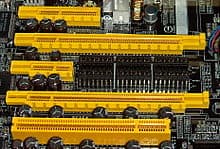Next Generation I/O (NGIO) a specification from the extinct Next Generation I/O (NGIO) Forum, was a high-speed, point-to-point interconnect architecture designed to meet the bandwidth, scalability, and reliability demands of future server and workstation environments. Developed in the late 1990s, NGIO was a significant step towards addressing the challenges posed by the rapidly expanding data and processing needs of enterprises and computing networks. However, NGIO ultimately merged with Future I/O, a competing standard, to form what is known today as InfiniBand.
NGIO was initially designed to replace the Peripheral Component Interconnect (PCI) system bus.
In this article:
- Historical Context and Development
- Key Features of NGIO
- Challenges and Limitations
- Merger with Future I/O and the Birth of InfiniBand
- Legacy and Impact
- Conclusion

1. Historical Context and Development
NGIO was introduced during a period marked by significant advancements in server and workstation technologies. The late 1990s witnessed a substantial increase in network traffic and data volumes, driven by the burgeoning internet, expanding enterprise networks, and complex computing applications. Traditional I/O (Input/Output) architectures, which were based on bus systems like PCI (Peripheral Component Interconnect), were becoming bottlenecks due to their limited bandwidth and shared bus topologies.
Intel led the development of NGIO with the support of several major hardware vendors. The initiative aimed to create an I/O architecture that could keep pace with the increasing demands for higher bandwidth, better scalability, and improved fault tolerance in servers and high-performance workstations.
2. Key Features of NGIO
NGIO’s design focused on several key areas to overcome the limitations of existing I/O architectures:
High-Speed Data Transfer
NGIO offered significantly higher bandwidth compared to traditional bus-based I/O architectures. This was achieved through point-to-point links, which provided dedicated bandwidth to connected devices, eliminating the shared bandwidth limitations of bus systems.
Scalability
Next Generation I/O was designed with scalability in mind, allowing for the easy addition of more I/O devices without a corresponding degradation in performance. This was crucial for server environments, where the ability to scale up resources as per demand is vital.
Improved Reliability and Fault Tolerance
NGIO incorporated advanced error detection and correction mechanisms to ensure data integrity and continuous operation, even in the face of hardware failures. This aspect was particularly important in mission-critical enterprise applications where downtime can have significant implications.
Support for Multiple Protocols
NGIO was intended to support a variety of communication protocols, making it a versatile solution for different types of data traffic, including storage, networking, and cluster communications.
To read next: Windows Kernel Attacks: Unveiling the Shadowy Underbelly!
3. Challenges and Limitations
Despite its advanced features, NGIO faced several challenges:
Competition and Standardization Battles
NGIO was not the only technology vying to replace traditional I/O architectures. Future I/O, a competing standard backed by companies like IBM and Hewlett-Packard, presented a significant challenge. The existence of two competing standards threatened to split the market, which could have led to compatibility issues and slowed down the adoption of either technology.
Technical and Commercial Viability
While NGIO was a promising technology, questions remained regarding its technical and commercial viability. The costs associated with implementing NGIO and the extent to which it could be integrated into existing systems were concerns for potential adopters.
4. Merger with Future I/O and the Birth of InfiniBand
The competition between NGIO and Future I/O was resolved in 1999 when the two groups decided to merge their efforts. This merger led to the creation of InfiniBand, a unified architecture that combined the best features of both NGIO and Future I/O.
InfiniBand took forward the vision of NGIO, offering a high-speed, scalable, and reliable interconnect architecture, and has since become a standard in high-performance computing and enterprise environments.
Read next: What is the Client-Server Model?
5. Legacy and Impact
The development of NGIO played a crucial role in the evolution of I/O technologies. It pushed the boundaries of what was possible in terms of speed, scalability, and reliability, setting the stage for the next generation of computing infrastructures. The ideas and innovations introduced by NGIO influenced subsequent developments in server and network architecture.
Even though NGIO itself did not become a standalone standard, its influence is evident in the features and capabilities of InfiniBand. The collaboration between NGIO and Future I/O proponents also demonstrated the importance of industry cooperation in developing new technologies and standards, a lesson that remains relevant in the fast-evolving world of technology.
6. Conclusion
Next Generation I/O was a pivotal development in the history of computing, representing a forward-thinking approach to addressing the challenges of a new era of data and network demands. Its merger with Future I/O and the subsequent development of InfiniBand marked a significant milestone in the evolution of server and network infrastructure technologies.
The legacy of NGIO lives on in the advanced capabilities of modern high-speed interconnects, underpinning the performance and efficiency of contemporary computing environments.